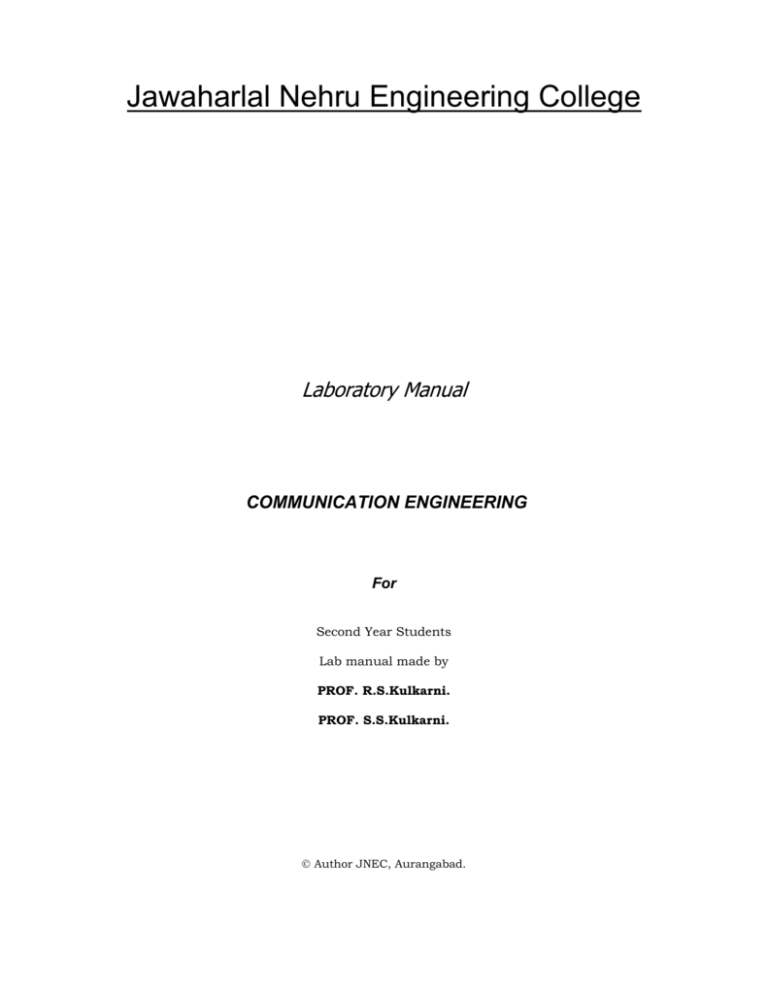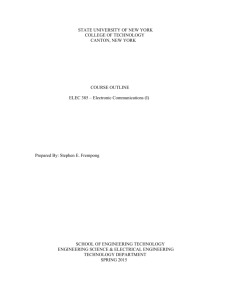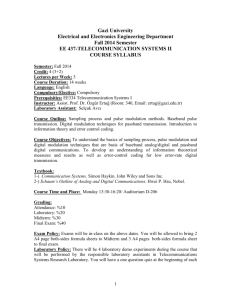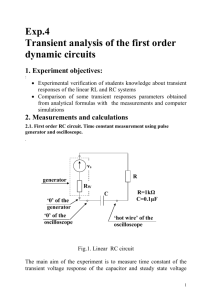Communication Engineering
advertisement

Jawaharlal Nehru Engineering College Laboratory Manual COMMUNICATION ENGINEERING For Second Year Students Lab manual made by PROF. R.S.Kulkarni. PROF. S.S.Kulkarni. Author JNEC, Aurangabad. FOREWORD It is my great pleasure to present this laboratory manual for second year engineering students for the subject of advance communication engineering keeping in view the vast coverage required for visualization of concepts of communication engineering. As a student, many of you may be wondering with some of the questions in your mind regarding the subject and exactly what has been tried is to answer through this manual. Faculty members are also advised that covering these aspects in initial stage itself, will greatly relieve them in future as much of the load will be taken care by the enthusiastic energies of the students once they are conceptually clear. HOD LABORATORY MANUAL CONTENTS This manual is intended for the second year students of ECT/IE branches in the subject of Advance Communication Engineering. This manual typically contains practical/Lab Sessions related to advance communication engineering, covering various aspects, related to the subject to enhance understanding. Students are advised to thoroughly go through this manual rather than only topics mentioned in the syllabus, as practical aspects are the key to understanding and conceptual visualization of theoretical aspects covered in the books. Good Luck for your Enjoyable Laboratory Sessions. Prof. R.S.Kulkarni. Prof. S.S.Kulkarni. SUBJECT INDEX 1. DOs and DON’Ts in Laboratory. 2.Lab exercise 1. Study of RF Signal Generator. 2. Modulation index calculation by trapezoidal pattern. 3. AM transmitter and receiver. 4. Frequency modulator and demodulator 5. Sampling and reconstruction. 6. Pulse width modulation. 7. Pulse position modulation. 8. Pulse code modulation. 3. Quiz on the subject. 4. Conduction Viva-Voce Examination. 5. Evaluation and Marking Systems. DOs and DON’Ts in Laboratory: 1. Do not handle any equipment before reading the instructions/Instruction manuals. 2. Read carefully the power ratings of the equipment before it is switched on whether ratings 230 V/50Hz or 115V/60 Hz. For Indian equipments, the power ratings are normally 230V/50Hz. If you have equipment with 115/60 Hz ratings, do not insert power plug, as our normal supply is 230V/50 Hz, which will damage the equipment. 3. Observe type of sockets of equipment power to avoid mechanical damage. 4. Do not forcefully place connectors to avoid the damage. 5. Strictly observe the instructions given by the teacher/Lab Instructor. Instruction for Laboratory Teachers: 1. Submission related to whatever lab work has been completed should be done during the next lab session. 2. The promptness of submission should be encouraged by way of marking and evaluation patterns that will benefit the sincere students. Experiment No.1 AIM: To study RF signal generator. APPARATUS: oscilloscope, function generator, probes, etc. THEORY: RADIO-FREQUENCY (RF) SIGNAL GENERATORS In addition to the necessary power supply, a typical RF signal generator contains three other main sections: an OSCILLATOR CIRCUIT, a MODULATOR, and an OUTPUT CONTROL CIRCUIT. The modulator modulates the RF signal of the oscillator. In addition, most RF generators are provided with connections through which an external source of modulation of any desired waveform can be applied to the generated signal. Metal shielding surrounds the unit to prevent signals from the oscillator from affecting the circuit under test. A block diagram of a representative RF signal generator is shown in figure. The function of the oscillator stage is to produce a signal that can be accurately set in frequency at any point within the range of the generator. The type of oscillator circuit used depends on the range of frequencies for which the generator is designed. In lower frequency RF signal generators, the oscillating circuit consists of one of a group of coils combined with a variable capacitor. One of the coils is selected by the position of a range selector switch that connects the coil to a capacitor to provide an inductance-capacitance circuit. The inductive-capacitance circuit then has the correct range of In resonant frequencies. amplitude modulation, the amplitude of carrier is changed in accordance with Instantaneous value of modulating signal. Fig: RF signal generator block diagram The function of the modulator is to produce an audio (or video) modulating signal that can be superimposed on the RF signal produced by the oscillator. The modulating signal may be provided by an audio oscillator within the generator. This is termed INTERNAL MODULATION. It may also be derived from an external source. This is termed EXTERNAL MODULATION. In some signal generators, either of these two methods of modulation can be employed. In addition, a means of disabling the modulator section is available so that the pure, un-modulated signal from the oscillator can be used when desired. Procedure:1. Connect the probe at output terminal of RF generator n another to the oscilloscope. 2. Check the different waveforms on oscilloscope. Conclusion:- Experiment No.2 AIM: To calculate modulation index of AM wave by using trapezoidal pattern. EQUIPMENT: AM modulator kit, oscilloscope, AF function generator, probes, wires etc. THEORY: In amplitude modulation, the amplitude of carrier is changed in accordance with the Instantaneous value of modulating signal. E= ( EC MAX + EM) sin wct Where em = Em max sin wmt is modulating signal. Ec= EC MAX sinwct is a carrier signal. E= [Ecmax + Em sin wmt ]sinwct . The modulation index is defined as , M= Emmax = Ecmax e= Ecmax(1+msinwmt)sinwmt or e=sinwct + m sinwmt . sinwct where Ecmax= 1v e= sinwct + m/2[cos(wc-wm)-cos(wc+wm) 1. First term is a carrier wave of amplitude 1v & frequency w=2 π fc. 2. The second term is a cosine wave of amplitude ½ m &frequency (fc-fm) this is lower side band (LSB). 3. The third term is a cosine wave of amplitude m/2 & frequency (fc+ fm). This is upper side band (USB). Measurement of carrier wave (RF wave) 1. Give supply to the kit of AM modulator. 2. The carrier wave must have generated carrier wave, open ckt. terminal a & b. 3. Connect probe to oscilloscope & other terminal ‘a’ & measure carrier voltage with respect to ground. 4. Measure the carrier wave & draw the waveform. Measurement of % modulation. 1. Give supply to the kit of AM modulator. 2. Now short-circuit the terminal a 6 b so that carrier voltages can be applied to the circuit. 3. Using function generator provides a selected frequency to the primary of transformer, which is at emitter of transistor. 4. Now connect probe from o/p ckt to the oscilloscope & measure the amplitude of Modulation Wave. 5. Calculate Emax (p-p) & Emin(p-p) for 3 set of different readings. OBSERVATION: %M EMax EMin x100 EMax EMin SR NO EMax (p-p) Conclusion: - EMin (p-p) %M Experiment No.3 AIM: - To study frequency modulator and Demodulator circuit. APPARATUS: - Matrix trainer kit - Frequency modulator, Function generator, Connecting wires, Oscilloscope THEORY:A modulator is a circuit which changes frequency of a carrier w.r.t. instantaneous amplitude of modulating signal while keeping other parameters constants. 1. Tuning – allows different channels to be selected. 2. Transmission range - as the carrier is high frequency the transmission range is high. 3. Practical antenna length – as the carrier frequency is high the antenna dimensions are small. 4. Wireless communication – as the carrier is radiated in air, wireless communication is possible. The F.M. (frequency modulator) is the circuit used for radio / T.V. communication and in other applications. The advantages of using F.M. are 1. Noiseless reception. 2. Operating range is large. 3. High frequency 4. High efficiency of transmission. CIRCUIT DESCRIPTION:The practical circuit of the frequency modulator is shown in figure. The circuit uses function generator I.C. XR 8038 this is a precise waveform generator IC capable of generating sine, square, triangular, sawtooth and pulse waveforms with a minimum number of external components and adjustments. Its operating frequency range is from 0.001Hz to 1 Mhz. The frequency of the waveform generator is direct function of d.c. voltage at terminal 7. Thus frequency modulation can be achieved by giving modulating signal to pin 7. The pin 2 output sine wave which is then frequency modulation by the modulating signal. The input modulating signal is applied to pin 7 and to pin 8 for small frequency deviation, large deviation are possible by connecting signal to pin 8 only. C2 and C3 is a timing capacitor. Selectable through J1 for two frequency range, the preset P5 connected at pin 4 and 5 are for adjusting duty cycle. The preset P3 and P4 at pin 1 and 12 adjusts the sine wave distortion. Pin 2 is sine wave output (modulated). POT P2 for carrier frequency adjustment. PROCEDURE 1. Keep the power switch on off condition. 2. Connect the power cord to mains supply. 3. Pot p1 works as attenuator provided for controlling the input to modulator (modulating signal). 4. Pot p2 is provided for carrier frequency variation from 70 KHz. to 110 KHz. 5. Put the power switch off the kits on and see the power switch glows. 6. Connect oscilloscope at output. 7. Set output frequency (carrier) above 80 KHz. With pot. P2 and j1 at b side. (j1 at a for low frequency carrier fm observation) 8. Connect the function generator sine wave output to modulator input (any frequency from 20 to 1 KHz). 9. Set the input amplitude with pot P1 such that modulation at the output is seen. 10. Observe and note the input frequency and output frequency on scope. 11. Repeat above experiment for no signal and at different frequencies. 12. Place J2 at A side and connect +v as modulating signal (AF input) and note dc voltages on pin 7 for minimum and maximum FM output frequencies. Demodulator In FM signal the amplitude of wave remain constant and modulated signal is used to change the carrier frequency. In such envelope detector can not be used for demodulating of those wave the circuit use to obtain modulating signal from FM wave are discriminator. The most commonly used discriminator are the faster seeley discriminator. Figure (1) shows the schematic diagram of faster seeley discriminator. It consists of two identical diode detector circuit L,S,D,R,C, AND LS2, D2,R2,C2 . The FM signal is inductively coupled to see. They also exist on a capacitive coupling between primary an centre tapped sec. the input of diode D1 = vector sum of the pri voltage. When incoming frequency is greater than fc then, sec. circuit behave as inductor and lags Vs by an angle less than 900. In the result, the ph. Relation of Vs1 and Vs2 with Vp becomes as shown in figure (20). Signal frequency smaller than the centre tapped fc. The secondary circuit behaves as capacitive and is leads Vs by 900 but the reference to centre point. They are 1800 out of phase as D1 is smaller than the vector sum of Vs2 and Vp. It can therefore concluded that effect variation in input signal amp. is to vary the +ve amp of output signal corres and the faster seely discriminator is sensitive output is always proceed by limiter. Block Diagram:- Balanced Modulator Circuit PROCEDURE 1. Connect the signal generator at input terminal and keep the signal level at suitable level. 2. Connect oscilloscope one at output and other at input. 3. Connect digital multimeter at output terminal. 4. Vary frequency in step and note down ph. Shift from oscilloscope. AF output on DMM. 5. Also observe the phase shift on oscilloscope when AF output is on the side and also on –ve side. CONCLUSION:- Experiment No.4 Aim:- To study AM transmitter & receiver. Apparatus :- Double side Band AM radio Receiver& transmitter Kits, CRO,CRO probes Theory :- The original broadcast RF signal is picked up by the aerial and selected by a relatively broadband RF filter. This signal is usually amplified before entering the mixer. The mixer then combines the incoming RF signal and the local Oscillator signal. Shift the input signal to a lower frequency. The mixer thus receives two RF signals- one at the true RF, direct from the tuned circuit, and one at RF plus an intermediate frequency (IF), direct from the local oscillator. The result of mixing the two is to extract the difference or beat frequency. This is the IF frequency which now contains the AF components of the original RF signal. The signal is then passed through a multiple stage fixed filter tuned at 455 kHz (which corresponds to the intermediate frequency). The filter has a bandwidth of 10kHz, which matches the bandwidth of each radio station. The IF signal is then amplified and subsequently passed through an envelope detector before AF amplification. The block diagram also shows feedback from the detector to the IF amplifier denoted as AGC or automatic gain control. This provides automatic regulation of the gain of the receiver in inverse proportion to the signal strength. This tends to keep the output level constant regardless of the input signal level eliminates much of the need to readjust the volume control when changing radio stations Wave form:- Procedure :( i ) Tracing Method to be followed. (II) Traced circuit diagram. (iii) Detection of fault. (iv) Interpretation of fault. Circuit diagram, Block diagram. (vi) Proper placement of components. Conclusion:- Experiment No.5 AIM: To study sampling of a siganl and it.s re-construction. THEORY: SAMPLING FREQUENCY: The 6.4 MHz Crystal oscillator generates the 6.4 MHz clock. The decade counter divides the frequency by 10 and the ripple counter generate the basic sampling frequencies -320KHz to 20 KHz and the other control frequencies. The basic sampling frequencies is given to a multiplexer For each "Press" on the frequency select switch, the output of the state counter increases by one and it counts from 000 to 100. As the state counter counts from 000 to 100, the corresponding input of the multiplexer is switched to the output. As soon as the count reaches 101, the output of the 3 to 8 decoder resets the state counter and the whole cycle repeats. Also LED connected to the output of the decoder is switch ON, which indicates the sampling frequency selected. Refer the truth table for better understanding. EQUIPMENTS: Analog Signal Sampling & Reconstruction Kit, 20 MHz Dual Trace Oscilloscope,Patch Chords PROCEDURE: 1. Connect power supply in proper polarity to the kit & switch on. 2. Connect the lKHz,5V pp Sinewave signal, generated onboard, to the ANALOG INPUT, by means of the patch-cords provided. 3. Connect the sampling frequency signal in the internal mode, by means of the shorting pin provided. 4. Using switch SW1 select 50% duty cycle as shown in the table. 5. Connect the SAMPLE OUTPUT to the input of the 2nd Order Low Pass Filter. 6. Using frequency selector switch, select desired sampling frequency. The selected sampling frequency is indicated by the glowing LED. 7. Take observation as mentioned below for various sampling frequency: 32 KHz, 16KHz, 8KHz, 4KHz , 2KHz. OBSERVATIONS:_ CONCLUSION: From the above observations we conclude that as the Sampling Frequency is increased, the reconstructed output is less distorted and almost original signal is reconstructed. For a sampling frequency of 2KHz, only 2 samples of the 1KHz signal are taken; whereas that for a sampling frequency of 8KHz, 8 samples of 1KHz signal are taken. Hence, as the number of samples taken of the signal increases, the distortion of the reconstructed signal decreases. As per the Nyquist Criterion atleast two samples are required for the reconstruction of the signal. If the Nyquist Criterion is not satisfied, or if the signal is not band-limited, then spectral overlap, called "aliasing" occurs, causing higher frequencies to show up at lower frequencies in the recovered message, and specially in voice transmission intelligibility is seriously degraded Thus, universally for the voice band (300Hz to 3300Hz), the sampling frequency used is 8KHz, which satisfies the Nyquist Criterion. Experiment No.6 AIM: To study pulse width modulation APPARATUS: Resistors ,capacitors, diode, IC 555 ,oscilloscope, function generator, probes. THEORY: Pulse width Modulation (PWM) is also known as Pulse duration Modulation (PDM). Three variations of PWM are possible. In One variation, the leading edge of the pulse is held constant and change in the pulse width with signal is measured with respect to the leading edge. In other Variable, the tail edge is held in constant and w.r.t to it, the pulse width is measured in the third variation, the centre of the pulse is held constant and pulse width changes on either side of the centre of the pulse. The PWM has the disadvantage when compared to ‘PDM’ that its pulses are of varying width and therefore of varying power content, this means the transmitter must be powerful enough to handle the max width pulses. The PWM is actually a square wave modulated. This modulation infects on the frequency (clock cycle) and the duty cycle of the signal. Both of those parameters will be explained in details later but keep in mind that a PWM signal is characterized from the duty clock and the duty cycle. The amplitude of the signal remains stable during time (except of course from the rising and falling ramps). The clock cycle is measured in Hz and the duty cycle is measured in hundred percent (%) Pulse Width Modulation Circuit Observation: Sr.no. Modulating input Modulating voltage Pulse width (tp) ∆tp Procedure : 1.Connect Vcc and ground to power supply. 2.Connect probe to oscilloscope and check its output at pin no. 3. Conclusion: Experiment No.7 AIM: To study pulse position modulation APPARATUS: Resistors, capacitors, diode, IC 555 ,oscilloscope, function generator, probes. THEORY: In Pulse Position Modulation, both the pulse amplitude and pulse duration are held constant but the position of the pulse is varied in proportional to the sampled values of the message signal. Pulse time modulation is a class of signaling techniques that encodes the sample values of an analog signal on to the time axis of a digital signal and it is analogous to angle modulation techniques. The two main types of PTM are PWM and PPM. In PPM the analog sample value determines the position of a narrow pulse relative to the clocking time. In PPM rise time of pulse decides the channel bandwidth. It has low noise interference. Pulse-position modulation (PPM) is a signal modulation used for both analog and digital signal transmissions. This method is widely used for optical communication systems such as optic fiber and IR remote controls, where efficiency is required and little or no external interference occurs. In PPM, data are transmitted with short pulses. All pulses have both the same width and amplitude. The parameter that changes is the delay between each pulse. Pulse Position Modulation Circuit Observation: Sr.no. Modulating input Modulating voltage Pulse position (td) ∆td Procedure : 1. Connect Vcc and ground to power supply. 2. Connect probe to oscilloscope and check its output at pin no. 3. Conclusion: Experiment No.8 AIM: To study pulse code modulation APPARATUS: PCM kit, oscilloscope, function generator, probes. THEORY: Pulse Code Modulation is also known as a digital pulse modulation technique. The pulse modulation (PCM) is quite complex compared to the analog pulse modulation techniques(i.e. PAM, PWM, PPM) in these sense that the message signal is subjected to a great number of operations. Fig. 1 shows the basic elements of a PCM system. It consists of three main parts i.e. transmitter, transmission path and receiver. The essential operations in the transmitter of a PCM system are sampling, quantizing and encoding as shown in fig.1. Sampling is operation in which an analog (i.e. continuous-time) signal is sampled according to the sampling theorem resulting in a discrete-time signal. The quantizing and encoding operations are usually performed in the same circuit which is known as an analog-to-digital converter (ADC). Also the essential operations in the receiver are regeneration of impaired signals, decoding and demodulation of the train of quantized samples. These operations are usually performed in the same circuit which is known as digital-to-analog converter (DAC). 4. Quiz on the subject: 1) What is standard IF value for AM receiver & FM receiver? 2) In a receiver which stage rectifies the IF signal? 3) From which component the three point tracking is achieved? 4) Define double spotting, image frequency, sensitivity, selectivity & fidelity . 5) Define carrier signal, modulating signal & modulated signal. 6) How many side bands exist in AM&FM? 7) Define frequency spectrum in AM. 8) What is the use of Bessel’s function? 9) What is the disadvantage of FM over AM? 10) What are the different types of detectors in AM & FM? 11) What are the different forms of AM? 12) What is AGC? What are its types? State use of it? 13) What is band spreading? 15) What is ganged tuning? 16) Which stage of AM & FM receiver determines the gain? 17) Define bandwidth. State the B.W. of AM & FM signal. 18) Define balanced modulator. 19) What are the o/p components of BM.? 20) What are the different types of BM? 21) ) What is SSB ? What are it’s types? 22) State the different AM & FM generation methods? 23) What is two & three point tracking? 24) What is IF of audio & video signal in TV? 24) What is aspect ratio? 25) What is PAL? 26) What is channel BW of TV signal? 27) What is interlaced scanning? 28) State the line frequency of TV system in India? 29) How many lines exist in one field in TV? 30) What modulation techniques are used for audio & video signal in TV? 31) What antenna is used for TV reception? 32) What is the use of pattern generator? 33) What is the voltage given to deflection coil? 34) Explain the role of horizontal & vertical blanking pulses? 35) The service range of TV transmitter is controlled by which parameter? 36) What is ghost image? 37) Which TV broadcasting system is used in India? 38) If the width of picture tube is 20 inch, what is it’s size? 39) Which type of focusing is used in TV receiver? 40) How many frames are transmitted per second in TV system? 41) What are the different types of picture tube distortions? 42) List out the TV receiver antennas. 43) What are the different types of camera tubes & picture tube? 44) What is persistence of vision? 45) What is ion trap? 5. Conduction of Viva-Voce Examinations: Teacher should conduct oral exams of the students with full preparation. Normally, the objective questions with guess are to be avoided. To make it meaningful, the questions should be such that depth of the students in the subject is tested. Oral examinations are to be conducted in co-cordial environment amongst the teachers taking the examination. Teachers taking such examinations should not have ill thoughts about each other and courtesies should be offered to each other in case of difference of opinion, which should be critically suppressed in front of the students. 6. Evaluation and marking system: Basic honesty in the evaluation and marking system is absolutely essential and in the process, impartial nature of the evaluator is required in the examination system. It is a wrong approach or concept to award the students by way of easy marking to get cheap popularity among the students, which they do not deserve. It is a primary responsibility of the teacher that right students who are really putting up lot of hard work with right kind of intelligence are correctly awarded. The marking patterns should be justifiable to the students without any ambiguity and teacher should see that students are faced with just circumstances.









